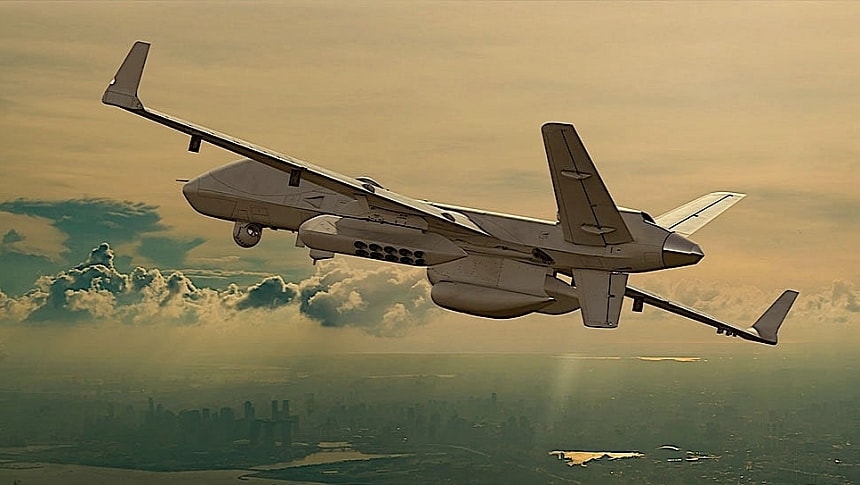Longe-range weapons are some of the most dangerous tools of war. Usually launched from places that are beyond the defenders' reach, they can strike fast and hard, most of the time without being touched by defenses. But now the U.S. is bringing the power of drones into play to counter them.
The MQ-9B SeaGuardian is one of the most potent maritime drones currently in the sky. Born as a variant of the SkyGuardian (it too an evolution of the MQ-9 Reaper, also known as the Predator B) in the stables of defense contractor General Atomics, it's meant to "deliver real-time situational awareness anywhere in the maritime domain."
The SeaGuardian has been designed in such a way as to operate for over 30 hours at a time. Because it's controlled via satellite, it has the ability to fly over the horizon to conduct patrol and reconnaissance missions for the military, or even humanitarian assistance and disaster relief for civilians.
The thing flies courtesy of a Honeywell turboprop engine that spins a rear-mounted propeller. It can take off weighing as much as 12,500 pounds (5,670 kg), climbing to a top altitude of 40,000 feet (12,200 meters).
The fastest the SeaGuardian can travel while in the air is 242 mph (389 kph), and it is able to reach distances located 5,750 miles (9,260 km) from where it departed.
Technically speaking the drone can be easily loaded with sensors in a bolt-on/bolt-off fashion, and that means it can be rapidly repurposed to conduct additional missions. Like, say, becoming a platform for the precision targeting of long-range weapons.
It is exactly this capability the drone maker and its partner in crime, Lockheed Martin, announced last week when it said it is now working to integrate something called the Net-Enabled Weapons (NEW) capability into the SeaGuardian.
The exact details on the system have not been released, but we do know it will rely on something called the SeaVue multi-role radar (made by Raytheon), coupled with the drone's "vast array of precision targeting sensors."
General Atomics already performed initial testing of the upgraded drone. The flights were conducted at the Navy's W-289 test range in Southern California and also involved an undisclosed number of F/A-18 airplanes.
As per the people on the project, the upgraded SeaGuardian will become better at conducting Intelligence, Surveillance, Reconnaissance and Targeting (ISR&T) missions, thus enabling more efficient kill chains and keeping manned aircraft away from the danger zone.
The drone is in itself relatively new, and has only been used so far in demonstrations during several exercises, including Northern Edge, Integrated Battle Problem, and Group Sail.
Up next for the people working on the project is taking the drone out at sea for overwater range test flights.
The SeaGuardian has been designed in such a way as to operate for over 30 hours at a time. Because it's controlled via satellite, it has the ability to fly over the horizon to conduct patrol and reconnaissance missions for the military, or even humanitarian assistance and disaster relief for civilians.
The thing flies courtesy of a Honeywell turboprop engine that spins a rear-mounted propeller. It can take off weighing as much as 12,500 pounds (5,670 kg), climbing to a top altitude of 40,000 feet (12,200 meters).
The fastest the SeaGuardian can travel while in the air is 242 mph (389 kph), and it is able to reach distances located 5,750 miles (9,260 km) from where it departed.
Technically speaking the drone can be easily loaded with sensors in a bolt-on/bolt-off fashion, and that means it can be rapidly repurposed to conduct additional missions. Like, say, becoming a platform for the precision targeting of long-range weapons.
It is exactly this capability the drone maker and its partner in crime, Lockheed Martin, announced last week when it said it is now working to integrate something called the Net-Enabled Weapons (NEW) capability into the SeaGuardian.
The exact details on the system have not been released, but we do know it will rely on something called the SeaVue multi-role radar (made by Raytheon), coupled with the drone's "vast array of precision targeting sensors."
General Atomics already performed initial testing of the upgraded drone. The flights were conducted at the Navy's W-289 test range in Southern California and also involved an undisclosed number of F/A-18 airplanes.
As per the people on the project, the upgraded SeaGuardian will become better at conducting Intelligence, Surveillance, Reconnaissance and Targeting (ISR&T) missions, thus enabling more efficient kill chains and keeping manned aircraft away from the danger zone.
The drone is in itself relatively new, and has only been used so far in demonstrations during several exercises, including Northern Edge, Integrated Battle Problem, and Group Sail.
Up next for the people working on the project is taking the drone out at sea for overwater range test flights.









